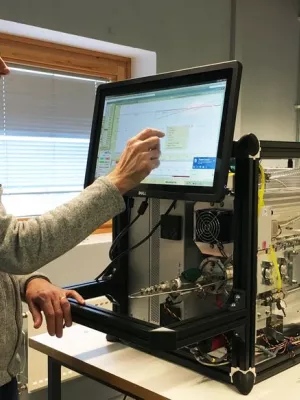
Erik Swietlicki
Professor

Tropical and Boreal Forest - Atmosphere Interactions : A Review
Författare
Summary, in English
This review presents how the boreal and the tropical forests affect the atmosphere, its chemical composition, its function, and further how that affects the climate and, in return, the ecosystems through feedback processes. Observations from key tower sites standing out due to their long-term comprehensive observations: The Amazon Tall Tower Observatory in Central Amazonia, the Zotino Tall Tower Observatory in Siberia, and the Station to Measure Ecosystem-Atmosphere Relations at Hyytiäla in Finland. The review is complemented by short-term observations from networks and large experiments.
The review discusses atmospheric chemistry observations, aerosol formation and processing, physiochemical aerosol, and cloud condensation nuclei properties and finds surprising similarities and important differences in the two ecosystems. The aerosol concentrations and chemistry are similar, particularly concerning the main chemical components, both dominated by an organic fraction, while the boreal ecosystem has generally higher concentrations of inorganics, due to higher influence of long-range transported air pollution. The emissions of biogenic volatile organic compounds are dominated by isoprene and monoterpene in the tropical and boreal regions, respectively, being the main precursors of the organic aerosol fraction.
Observations and modeling studies show that climate change and deforestation affect the ecosystems such that the carbon and hydrological cycles in Amazonia are changing to carbon neutrality and affect precipitation downwind. In Africa, the tropical forests are so far maintaining their carbon sink.
It is urgent to better understand the interaction between these major ecosystems, the atmosphere, and climate, which calls for more observation sites, providing long-term data on water, carbon, and other biogeochemical cycles. This is essential in finding a sustainable balance between forest preservation and reforestation versus a potential increase in food production and biofuels, which are critical in maintaining ecosystem services and global climate stability. Reducing global warming and deforestation is vital for tropical forests.
The review discusses atmospheric chemistry observations, aerosol formation and processing, physiochemical aerosol, and cloud condensation nuclei properties and finds surprising similarities and important differences in the two ecosystems. The aerosol concentrations and chemistry are similar, particularly concerning the main chemical components, both dominated by an organic fraction, while the boreal ecosystem has generally higher concentrations of inorganics, due to higher influence of long-range transported air pollution. The emissions of biogenic volatile organic compounds are dominated by isoprene and monoterpene in the tropical and boreal regions, respectively, being the main precursors of the organic aerosol fraction.
Observations and modeling studies show that climate change and deforestation affect the ecosystems such that the carbon and hydrological cycles in Amazonia are changing to carbon neutrality and affect precipitation downwind. In Africa, the tropical forests are so far maintaining their carbon sink.
It is urgent to better understand the interaction between these major ecosystems, the atmosphere, and climate, which calls for more observation sites, providing long-term data on water, carbon, and other biogeochemical cycles. This is essential in finding a sustainable balance between forest preservation and reforestation versus a potential increase in food production and biofuels, which are critical in maintaining ecosystem services and global climate stability. Reducing global warming and deforestation is vital for tropical forests.
Avdelning/ar
- Institutionen för naturgeografi och ekosystemvetenskap
- BECC: Biodiversity and Ecosystem services in a Changing Climate
- Kärnfysik
- LTH profilområde: Aerosoler
- MERGE: ModElling the Regional and Global Earth system
Publiceringsår
2022
Språk
Engelska
Sidor
24-163
Publikation/Tidskrift/Serie
Tellus, Series B: Chemical and Physical Meteorology
Volym
74
Dokumenttyp
Artikel i tidskrift
Förlag
Taylor & Francis
Ämne
- Meteorology and Atmospheric Sciences
Status
Published
ISBN/ISSN/Övrigt
- ISSN: 0280-6509